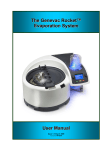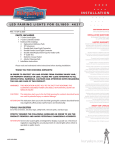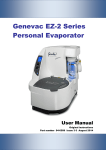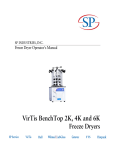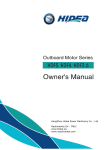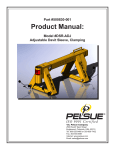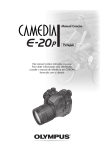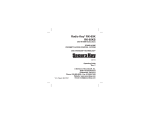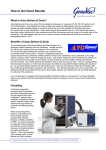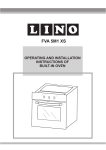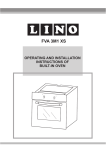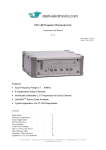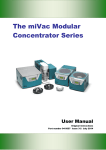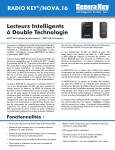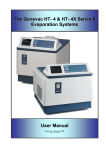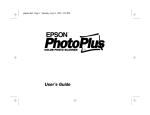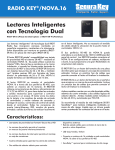Download The Genevac Rocket™ Evaporation System User Manual
Transcript
The Genevac Rocket™ Evaporation System User Manual Issue 1-13 February 2009 Part Number 04-6276 Contents Safety ............................................................2 Guide to Solvent Groups.............................3 List of Acceptable Solvents ............................. 4 System Overview .........................................5 Vacuum System Schematic ............................ 7 Quick Reference Guide ...............................8 Switching On ................................................... 8 Using the Controls ........................................... 8 Vacuum Chamber Water Reservoir ................ 8 Getting Started ................................................ 9 Sample Flasks ............................................10 Standard Flask .............................................. 10 SampleGenie™ Vial System ......................... 10 Instructions for Use........................................ 10 SampleGenie™ GC Vial System................... 11 Instructions for Use........................................ 11 Detailed Operation .....................................13 Switching On ................................................. 13 Menu Control ................................................. 13 Optimising Condenser Performance ............. 14 Preparing the Evaporator .............................. 15 Loading Samples........................................... 16 Starting / Stopping a Run (Method)............... 17 Changing Method Settings during a Run ...... 17 Method Running Screen................................ 18 System Test................................................... 19 Draining the Condenser ................................ 20 Downloading Log Files .................................. 21 Transferring Method Files ............................. 22 Options Menu ................................................ 23 Maintenance Menu ........................................ 24 The following table shows the options and information that appears:- ............................. 24 View Last Method Graph............................... 24 About Menu ................................................... 25 Upgrading the Software................................. 25 Method Edit Menu ......................................... 26 Using the Strobe............................................ 28 Replacing the Vacuum Pump ........................ 33 Replacing the Flask Seals ............................. 35 Draining the Condenser Coolant ................... 36 Removing / Replacing the Condenser ........... 38 Removing / Replacing the Rotor.................... 40 Removing / Replacing the Flask Adapter Cushions ........................................................ 42 Cleaning the Sample Viewing Window .......... 44 Recovery From A Critical Failure................... 45 Opening the Lid during a Power Failure ........ 45 Recovering Broken Glassware ...................... 45 Installing the System.................................46 Installation Overview...................................... 46 Preparing the Installation Site........................ 46 Positioning the Evaporator............................. 47 Option 1: Positioning the Re-circulating Cooler ....................................................................... 47 Positioning the Waste Solvent Container ...... 48 Connecting the Solvent Drain and Exhaust Pipes .............................................................. 48 Option 1: Connecting the Re-circulating cooler ....................................................................... 49 Option 2: Connecting to a Running Cold Water Supply ............................................................ 51 Powering up ................................................... 51 Filling the Vacuum Chamber Water Reservoir ....................................................................... 51 Technical Specifications...........................52 Mechanical Data ............................................ 52 Condenser ..................................................... 52 Vacuum System............................................. 52 Vacuum Pump ............................................... 52 Power Supplies .............................................. 52 Power Consumption....................................... 52 Operating Environment .................................. 52 Storage / Transporting Environment.............. 52 Emissions....................................................... 52 Electrical Earthing .......................................... 52 Warranty Statement...................................53 Maintenance and Cleaning........................29 Returning Equipment to Genevac............53 Routine Maintenance to be Carried out before Each Use ....................................................... 29 Routine Maintenance to be Carried out after Every Use ...................................................... 29 Further maintenance procedures to be carried out periodically............................................... 29 Recommended Practice ................................ 30 Error Messages and Fault Finding ................ 31 Consumable Parts .....................................54 Model / Serial Number...............................54 Notes.............................................................. 55 EC Declaration of Conformity - Rocket Evaporator ..................................................... 56 Amendment Control Form ........................57 Rocket Evaporation System User Manual Safety Warning This symbol is used throughout this manual. It indicates a hazard that can lead to material damage or potential injury. The following safety precautions should always be observed when using the evaporator: • • • • • • • The exhaust pipe should be connected to a suitable laboratory fume extraction system Place the system in a ventilated space Clean up any solvent spillage within the evaporator immediately Empty the waste solvent vessel before every use Dispose of waste solvents in accordance with local environmental regulations Refer to the list of acceptable solvents before use Take care when using the optional strobe function. Persons in the vicinity may suffer adverse effects if prone to epileptic seizure Genevac Evaporators and Combustible Solvents Please note it remains the responsibility of the user to consider safety when evaporating any combustible solvents. The Genevac position regarding evaporation of such solvents, particularly with respect to the European ATEX directive, is available on our website or from your local sales representative. Limitations of use Your evaporator is not suitable for use under the following circumstances: • • • • With strong mineral or halogenated acids such as HCl and HBr at any concentrations Evaporating Diethyl Ether and similar low auto-ignition solvents (unless fitted with an Inert Gas Purge System) For evaporating Solvents with a boiling point greater than 160°C at atmospheric pressure. For use as a pressure vessel Lid Operation The electrically operated lid lock is controlled by a system of safety sensors. The lid cannot be opened while the rotor is spinning; the evaporator is under vacuum or when the power is switched off. Electrical Earthing This system must be earthed. This Evaporator is a Safety Class I product according to IEC classification. It must never be used with any interruption to the safety earth conductor. It is an installation category II product and is intended to operate from a normal single phase supply. 2 04-6276 Issue 1-13 February 2009 User Manual Rocket Evaporation System Recommended Practice A few general rules for safe operation of the system: • • • • • • Only users familiar with all the issues outlined in this manual should be permitted to operate the equipment Do not start, or restart a system without checking that the rotor is balanced and correctly loaded Do not placing any objects on top of the evaporator Take care when loading. Incorrect loading may result in damage to samples and / or the evaporator, and could void the warranty Maintain a solvent free environment around the Evaporator. Do not use free space around the evaporator for storing vessels containing solvents or acids Follow the Maintenance and Cleaning Procedures outlined within this manual Maintenance Maintenance procedures should only be carried out by a competent person. Guide to Solvent Groups The evaporator is supplied with a number of preloaded standard methods. If any or all of the standard methods are unavailable, it is likely that they have been overwritten (deleted). See Transferring Method Files for advice on safe keeping of methods. Do not attempt to evaporate high boiling point solvents (160º C or above at atmospheric pressure). This includes DMSO, DMI and NMP. Attempting to evaporate these solvents could cause damage to the evaporator vacuum system. Do not attempt to evaporate strong halogenated acids (such as HCL and HBr) or mineral acids at any concentration. 04-6276 Issue 1-13 February 2009 3 Rocket Evaporation System User Manual List of Acceptable Solvents The following table lists commonly used solvents which are compatible for use in the evaporator. Solvents are grouped according to boiling point and the table shows the appropriate standard method to use. Contact your local Genevac agent for advice on solvents which are not listed. Method Location 01 Standard Method (Solvent group) Very Low BP 02 Low Boiling Point 03 Medium BP 04 05 06 07 08 Aqueous Low BP Mixture Med & Low BP Mixture List of Acceptable Solvents Dichloromethane (DCM) **Diethyl Ether **Pentane Acetone Acetonitrile (ACN) Butyl Acetate Chloroform (TCM) 1,2-Dichloroethane (DCE) *Dioxane Ethyl Acetate *Heptane Hexane (Hex) Methanol Propan-1-ol or Propanol *Propan-2-ol or isopropyl alcohol (IPA) *Pyridine Tetrahydrofuran (THF) Trifluroacetic Acid (TFA) Acetic Acid Ammonium Hydroxide (NH3OH) *Ethanol (EtOH) Dimethyl Formamide DMF Formic Acid *Toluene Butan-1-ol *Butan-2-ol Water Any mixture of low boiling point solvents (except DCM) Any mixture of medium and low boiling point (refer to rest of table) HPLC Fractions (Water / organic mixture) Water / Acetonitrile or Methanol DCM mixture Dichloromethane (DCM) and other miscible solvents and no traces of water * Some solvents can be evaporated using either the Low Boiling Point or the Medium Boiling Point method. For these solvents, use Low Boiling Point to optimise solvent recovery, or Medium Boiling Point to optimise speed. ** Evaporating Diethyl Ether, pentane or other similar low auto-ignition solvents may only be attempted in an evaporator which is fitted with an Inert Gas Purge system. 4 04-6276 Issue 1-13 February 2009 User Manual Rocket Evaporation System System Overview Outer (Main) Lid Condenser Strobe Control Menu Screen Inner (Rotor) lid Sample Viewing Window Menu Control Run Controls: Start, Pause, Stop USB Port Power Switch Waste Solvent Drain Outlet Lifting points The Rocket Evaporation System is designed for ease of use and very fast concentration or drying times. User interface is via an LCD menu screen coupled to a twist and push menu control system. Simple menu options provide quick access to everyday functions and advanced features are intuitive to use. The menu screen displays at-a-glance system status information. Samples can be monitored using the sample viewing window in conjunction with a variable timing strobe system (this is an optional feature). Simple start, stop and pause keys are used to control a run. The evaporator automatically records log files which can be used for method certification purposes. A USB port allows connection of a data storage device (not supplied) so that log files can be downloaded for transfer to a remote computer. Software upgrades or new methods can also be uploaded via a USB data-key. 04-6276 Issue 1-13 February 2009 5 Rocket Evaporation System User Manual Solvent is recovered by a highly efficient vapour condenser which can be set up to drain the waste solvent automatically. The plastic coated glass condenser is powered by cold water from an external source. There are two possible methods of supplying cold water to the condenser. These methods are referred to within this manual as follows:option 1: The evaporator is connected to a re-circulating cooler. option 2: The evaporator receives coolant water from a running cold water supply. The outer lid is electronically locked during operation to prevent unsafe opening. It is opened manually to provide access to the main vacuum chamber and inner lid. A thumb screw releases the inner lid allowing access to the rotor. The rotor is compatible with Genevac Standard drying flasks or the Genevac SampleGenieTM flask into vial concentration system. Outer lid Seal Seal Clamp Sample Flask Rotor Inner Lid seal O ring Sample Holder Basket and Adaptor Blanking Plug Inner lid Mounting Hub 6 04-6276 Issue 1-13 February 2009 User Manual Rocket Evaporation System The outer lid isolates the evaporator vacuum system from the outside world. When the inner lid and sample flasks are fitted, they form a seal between the inner (rotor) chamber and outer chamber allowing independent vacuum control of each. The flask seals form a vacuum seal when the rotor spins but also allow easy loading and unloading of the sample flasks into the stationary rotor. This is achieved by a unique seal clamping system which applies force, compressing the flask seals under centrifugal acceleration. It is essential that the flasks and flask seals are kept clean and in good condition. Unused rotor positions must be fitted with blanking plugs (or sealed with empty flasks). Vacuum System Schematic Outer Chamber Condenser Inner Chamber Coolant Water Condenser Drain Vacuum Controller • • 04-6276 Issue 1-13 February 2009 Outer chamber vacuum circuit is shown in green Inner chamber vacuum circuit is shown in red 7 Rocket Evaporation System User Manual Quick Reference Guide Switching On Ensure mains power is connected and switched on. The power switches are located here. Evaporator Optional re-circulating cooler Using the Controls Strobe control: Press the control and follow the on screen instructions Menu Control: Navigate around the menu screens. Turn to scroll, press to select. Run Controls: Start, stop and pause Vacuum Chamber Water Reservoir Correct water level:- Use deionised water only (resistivity 50,000 to 1 megohm at pH >6.5 and particulate free). Volume required to fill from empty: 250ml. • Above low water level marker • Below high water level marker The outer lid and inner lid may reach temperatures of up to 60°C when the evaporator is operating. 8 04-6276 Issue 1-13 February 2009 User Manual Rocket Evaporation System Getting Started The following guide is a reminder for initiated users. Refer to the relevant section of this manual for detailed description of features and operating procedures. 1. Switch on the evaporator. The menu screen runs through a software boot up sequence before the Method Select menu opens. Sys Use Checks appear on the menu screen if the function is enabled (in the Options menu). Complete the checks and then press the menu control to escape the check list and enter the Method Select menu. 2. Turn on the coolant supply. The procedure varies according to the installation option:Option 1: Switch on the re-circulating cooler. Option 2: Turn on the running cold water supply. 3. Inspect the condenser. If any solvent is present, drain the condenser. Use the menu control to select the Drain Condenser option from the Method Select menu. Wait until the menu screen countdown elapses or press any button to stop draining when the condenser is empty. 4. Empty the waste solvent container. 5. Check the vacuum chamber water reservoir level. Top up using deionised water (resistivity 50,000 to 1 megohm at pH>6.5 and particulate free). The correct water level is between the circular low level marker, and the triangular high level marker as shown in the Vacuum Chamber Water Level illustration on the page opposite. 6. Load the samples: Balance opposing sample flasks within 10g. Avoid cumulative rotor imbalance by distributing minor weight variances around the rotor. Fit blanking plugs or empty standard flasks to unused rotor positions. 7. Use the menu control to highlight the method required. 8. Press the start key to commence the method. Pre-Run Checks appear on the menu screen if the function is enabled (in the Options menu). Complete the checks and press the menu control to exit the check list and commence the method. 9. Information relating to sample drying progress is displayed on the menu screen whilst the evaporator is operating. Samples may also be monitored using the strobe and sample viewing window (if the evaporator has this option fitted). Note: For manual override: Press the pause key to interrupt a run. There is now a 15 minute time interval during which the run may be resumed. Press the stop key to end a run. The only way to restart is to begin a new run. 10. Unload the samples after the evaporator stops at end of run. 04-6276 Issue 1-13 February 2009 9 Rocket Evaporation System User Manual Sample Flasks A variety of sample flask systems are available for use with the Genevac Rocket Evaporation System. Standard Flask The standard flask is designed for general sample drying. Place the flasks in the flask holder to fill them with samples. The dried product may be re-suspended after evaporation, or scraped from the “nose” of the flask. SampleGenie™ Vial System The SampleGenie Vial System is designed for drying samples directly into vials. Fig 1 Instructions for Use 1. Insert a vial seal into the neck of a flask, chamfer side down. Push it down until the seal locates against the glass shoulder (Fig 1). Note: Standard SampleGenie vial seals are manufactured from low leachable viton. Perfluoroelastomer seals are also available. Fig 2 2. Place a flask collar, with collar pad inserted, over the neck of the flask (Fig 2) 3. Place a vial into a vial adapter (Fig 3). 4. Screw an assembled flask, flask collar and collar pad onto the vial adapter (Fig 4). Never place a flask, vial and vial adapter assembly into the rotor without a flask collar / collar pad assembly. Fig 3 Fig 4 10 5. Repeat steps 1 to 4 for the remaining sample flasks. 6. Place the flask assemblies into the flask holder to fill them with samples. Note: Inspect the collar pads periodically and replace them if necessary. To replace the collar pad: remove the flask collar from the flask and discard the defective collar pad. Press a new collar pad flat and then fold it. Insert the folded collar pad into the flask collar. The collar pad unfolds into the correct position when released. 04-6276 Issue 1-13 February 2009 User Manual Rocket Evaporation System SampleGenie™ GC Vial System The GC vial adapter is used for concentrating samples into vials. Its design minimises the heat transfer into the vial. The evaporator detects a slowing of evaporation when the solvent level drops below the neck of the flask, enabling a method to be set to end the run with a finite volume of solvent remaining. GC Vial Adapter Instructions for Use 1. Fig 1 Insert a vial seal (Fig 1) into the neck of a flask and push down until the seal locates against the glass shoulder (Fig 2). Note: The standard SampleGenie GC vial seals are manufactured from low leachable viton, perfluoroelastomer seals are also available. 2. Place a vial into a vial holder (Fig 3). Fig 2 Fig 3 04-6276 Issue 1-13 February 2009 11 Rocket Evaporation System Fig 4 User Manual 3. Place the assembled vial and vial holder into a flask cap (Fig 4) 4. Screw a flask onto the vial / cap assembly (Fig 5). Take care to ensure the vial aligns centrally with the vial seal. 5. Repeat the procedure for all other sample flasks and place the flask assemblies into the flask holder in preparation for filling with samples. Note: The SampleGenie GC Vial System is designed to accommodate Crimp Top GC vials. Contact your local distributer or Genevac Ltd for advice on the compatibility of alternative vials. Fig 5 Remove the flasks from the evaporator carefully. They are likely to be hot and wet. Place the flasks in the flask holder to fill with samples. Seal the flasks using a flask bung before transporting the flasks in the flask holder. Do not mark or apply labels to the sample flasks around or below the level where the rotor flask seal locates when the flasks are loaded into the rotor. Do not fill flasks above the maximum fill level indicated on the side of the flasks. Ensure that the flasks are clean and undamaged before every use. Scratched or damaged flasks may break resulting in unrecoverable sample loss and possible damage to the evaporator. Replacement or spare flask sets are available. Contact your local Genevac agent for details. 12 04-6276 Issue 1-13 February 2009 User Manual Rocket Evaporation System Detailed Operation Switching On The following instructions assume the evaporator is set up in accordance with the instructions in Installing the System. 1. Switch on power to the Evaporator. The Method Select menu is displayed after the software boot-up sequence completes. Note: Commissioning checks or Sys Use checks may appear on the screen. (These functions may be enabled or disabled from the Options menu.) Press the start key to confirm the checks have been completed and to go to the Method Select menu. Evaporator Power Switch 2. Turn on the coolant supply using the appropriate method:Option 1 (Coolant is supplied by a re-circulating cooler.) Switch on power to the re-circulating cooler. The recirculating cooler performs a short self test and then starts up displaying r OFF, indicating it is operating in remote control mode (this assumes the system has been set up in accordance with the instructions in Installing the System). The evaporator now has control of the re-circulating cooler. Re-circulating Cooler Power Switch Refer to the re-circulating cooler Operating Manual for details of how to:• • Switch on the re-circulating cooler Set the re-circulating cooler mode to remote control Option 2 (Coolant is supplied from a running cold water supply.) Turn on the cold water supply. Note: Coolant flow is controlled by a water valve within the evaporator. The evaporator shuts the water valve to prevent water wastage when the evaporator is not running. Menu Control Operate the Menu Control as follows:• • • Menu Control Turn the menu control to scroll through and highlight the menu options Press the menu control to select the highlighted option Exit a menu by scrolling to and selecting <BACK> Follow other instructions that may appear on the screen. 04-6276 Issue 1-13 February 2009 13 Rocket Evaporation System Evaporator Serial Port User Manual Optimising Condenser Performance The benefits of optimising the condenser performance are:• • Quick evaporation times Efficient solvent recovery To ensure the best possible performance from the condenser:• • Drain the condenser before starting a run Ensure the coolant supply temperature is appropriate for the (solvent group) application Option 1: Check to ensure:Re-circulating cooler Serial Port • • The re-circulating cooler is connected to the evaporator via a serial lead The re-circulating cooler display shows r OFF at start up, indicating the remote control function is enabled. Refer to the re-circulating cooler Operating Manual for details Note: The evaporator controls the re-circulating cooler ensuring appropriate coolant supply temperatures at all times. The optimum coolant supply temperature for an application is defined within the relevant method. The evaporator also switches off the re-circulating cooler when the system is idle. Where remote control of the re-circulating cooler is impossible (e.g. an alternate re-circulating cooler is being used) the coolant supply temperature must be set manually. Consider the following points when setting the coolant supply temperature:• Do not use coolant temperatures lower than +5°C when evaporating water • Use -15°C (or the lowest possible coolant temperature available) when evaporating all solvents other than water Refer to the re-circulating cooler Operating Manual for details of how to check and top up the coolant level. Use a 50/50 mixture of water glycol. Note: If glycol is unavailable, 100% water may be used as a temporary measure. In this case set the coolant supply temperature to +5°C to prevent coolant freezing. Evaporation performance will be compromised. Option 2: Ensure that the running cold water supply conforms to requirements for temperature, pressure and flow rate. See Technical Specifications: Cold Water Supply. 14 04-6276 Issue 1-13 February 2009 User Manual Rocket Evaporation System Preparing the Evaporator The following procedure assumes the evaporator is set up in accordance with instructions in Installing the System. 1. Ensure that:Option 1: The re-circulating cooler is switched on and filled to the correct level with coolant. Refer to the recirculating cooler Operating Manual for details. Option 2: The cold water supply is turned on. Waste solvent drain hose Ensure the end of the waste solvent hose remains above the level of the waste solvent 2. Check the condition of the waste solvent drain hose. The drain hose must provide unimpeded drainage of waste solvent into the waste solvent container. The end of the waste solvent pipe must not be allowed to submerge below the level of the waste solvent. 3. Check the condenser. Drain any waste solvent from the condenser. 4. Empty the waste solvent container. Note: Waste solvent may drain periodically whilst the evaporator is operating. 5. Ensure the chamber water reservoir is filled to the level shown inside the chamber. Correct water level:• • Above the circular low level marker Below the triangular high level marker Use 250ml if filling the chamber water reservoir from empty. Chamber Water Level Low level marker Note: Use only deionised water (resistivity 50,000 to 1 megohm at pH >6.5 and particulate free) in the chamber reservoir. The evaporator is now ready for the samples to be loaded. Refer to Loading Samples for details. High level marker 04-6276 Issue 1-13 February 2009 15 Rocket Evaporation System User Manual Loading Samples Inner lid Ensure that flasks are clean and undamaged before every use. Scratched or damaged flasks may break causing unrecoverable sample loss and possible damage to the evaporator. The outer lid, inner lid and sample flasks may reach temperatures of up to 60°C whilst the evaporator is operating. They may also be wet causing them to drip or be slippery when handled. Inner lid Thumb Screw 1. Open the outer lid. Note: The lid lock is electrically operated and is controlled by a system of safety sensors. The lid cannot be opened whilst the rotor is spinning, the evaporator is under vacuum or when the power is switched off. 2. Remove the inner lid by unscrewing the inner lid thumb screw and lifting the inner lid away from the rotor. Store the lid safely. 3. Ensure the samples are balanced. The evaporator can tolerate an imbalance of 40g across the rotor, however it is recommended that individual samples should be balanced within 10g with minor variations distributed evenly around the rotor. This prevents cumulative rotor imbalance. Inner lid Stand Rotor imbalance Individual samples balanced within 10g, but cumulative imbalance across rotor. Rotor balanced Do not fill the sample flasks above the safe fill level marker. 4. Samples balanced and minor variances distributed around rotor. Load the sample flasks into the rotor. Carefully twist the flasks whilst easing into the rotor basket. Push the flasks all the way down, there should be very little resistance to insertion of the flask until the shoulder of the flask rests against the rotor basket. Fit blanking plugs into any unused rotor positions. Empty standard flasks may be used as an alternative to blanking plugs. 5. Replace the inner lid and secure with the thumb screw. Turn the thumb screw clockwise until light resistance is felt. Tighten by continuing to turn clockwise for a further three quarters of a turn. 6. Close the outer lid. The evaporator is now ready for use. Scroll to the required method in the Method Select menu and press start key to commence the method. 16 04-6276 Issue 1-13 February 2009 User Manual Rocket Evaporation System Starting / Stopping a Run (Method) 1. Scroll to highlight the required method in the Method Select menu. 2. Press the start key 3. to commence the method. • The evaporator displays the method settings momentarily whilst the rotor spins up. • Pre Run Checks may appear on the menu screen (this function is enabled or disabled from the Options menu). Complete the checks and press the start key to exit the checks screen and commence the method. • The evaporator vents to atmospheric pressure and stops the rotor spinning when the method is complete. To over ride the method and stop the run manually:• Press the pause key • Press the stop key The run be resumed later The run cannot be restarted Note: Methods consist of several stages which commence consecutively, for example: a ramping (dri-pure™) stage is followed by the evaporation stage, which is followed by a final drying stage. All methods are preceded by a system safety check which includes a lid integrity test to ensure that vacuum can be achieved before allowing the method to commence. Changing Method Settings during a Run Method settings may be changed whilst the method is in progress. Using the menu control:1. Press to enter the method menu. 2. Select the required parameter. 3. Select a new setting. Scroll through the available setting options and select the required value. 4. Select <BACK> to return to method running screen. automatically after a short time. Alternatively the system returns Note: A method is altered permanently when a setting is changed during a run. See Method Edit Menu for details. Methods that are locked (indicated by a locked padlock icon) cannot be changed. 04-6276 Issue 1-13 February 2009 17 Rocket Evaporation System User Manual Method Running Screen The menu screen displays information relevant to system status and sample drying progress during the progression of a method. Current method stage Method identity Water temperature Rotating arrows indicate rotor is spinning Inner (rotor) chamber vacuum Graph shows ∆T* against time and is proportional to rate of evaporation Condenser supply temperature Delta T * Current status: Elapsed method time * ∆T is the difference between coolant temperature at the evaporator coolant inlet and outlet. This difference is proportional to the amount of vapour entering the condenser and relates to the rate of evaporation. ∆T is used by the evaporator software to predict when the end of run may occur and to detect when the end of run actually occurs. Disregard erratic anomalies that occur in ∆T during the early stages of a method. External effects cause uneven warming of the coolant pipes during standby and it takes around five minutes for the coolant temperature to stabilise. The menu screen shows a dotted line at the predicted end of run time. Key to Screen Icons Contact Genevac for advice An error has occurred Press start key for function Rotor is spinning Delta T Initiating USB device Water temperature Time Elapsed USB device working Inner Chamber Vacuum Power save function enabled Method not locked Condenser coolant supply temperature Strobe operating These are examples of commonly used screen icons. Other screen graphics with intuitive meaning may also appear on the menu screen. 18 04-6276 Issue 1-13 February 2009 User Manual Rocket Evaporation System System Test Use the System test to test the vacuum system. 1. Remove the water from the Vacuum Chamber Water Reservoir. 2. Drain the condenser. 3. Fit blanking plugs (or empty flasks) to all rotor positions. 4. Fit the Inner lid. 5. Select Medium BP method from the Method Select Menu. 6. Press the start key 1 hour. and allow the method to operate for Note: the above procedure ensures all traces of water and solvent are removed from the vacuum system. The presence of water or solvent invalidates the test. 7. Turn off the re-circulating water cooler. 8. Select System test from the Method Select menu. 9. Press the start key 10. Any faults encountered during the test are displayed on the menu screen in the form of short descriptive message and an error number. See Error Messages and Fault Finding for details. The menu screen also confirms the successful completion of a System Test, with no error deteced. to commence the System test. Note: Contact your local Genevac representative or Genevac Service Department for advice on decoding error numbers which are not listed in this manual. 04-6276 Issue 1-13 February 2009 19 Rocket Evaporation System User Manual Draining the Condenser 1. Select the Drain Condenser option from the Method Select menu. 2. Press the Menu Control or start key request to drain. • • • to confirm the The condenser drain valve opens for six minutes, allowing the condenser to drain A countdown timer appears on the screen The drain operation can be stopped by pressing any key 3. Inspect the condenser glass to ensure that all of the solvent has drained. 4. Empty the waste solvent container. Note: A method may specify an automatic drain sequence between method stages or at end of method. Manual draining of the condenser will not be necessary in this case. 20 04-6276 Issue 1-13 February 2009 User Manual Rocket Evaporation System Downloading Log Files Data is collected during the progression of a method. The resulting log files may be used for method verification purposes. Each log file is assigned an eight digit reference number. The first four digits of the reference number are the evaporator serial number. The next four digits form a unique identifier which increments upwards with each successive use. The evaporator’s internal memory can hold up to four completed run log files. The oldest log file is overwritten once the memory is full. Alternatively, connect a USB data key before commencing the method. The evaporator logs files directly to the data key. Note: Log files record temperature in °C and pressure in millibar, regardless of the pressure and temperature unit options selected from the Options menu. USB data key Following these instructions to retrieve internally logged files from the evaporator:1. Insert a USB data key into the USB port located beneath the left hand side of the control panel. The evaporator acknowledges the presence of a data key by emitting a beep and displaying an icon on the menu screen. 2. Select File Transfer from the Method Select menu. 3. Select Copy Log Files to Datakey. 4. Select the log file to be copied. 5. Repeat the procedure for any remaining log files that require to be copied. 6. Select <BACK> to exit the File Transfer menu. 7. Upload the log files from the data key to a PC. 04-6276 Issue 1-13 February 2009 21 Rocket Evaporation System User Manual Transferring Method Files The File Transfer facility enables new methods to be installed. Bespoke methods are available from Genevac by email. Contact your local Genevac representative for details. Follow these instructions to install new method files:1. Create a root folder entitled Rocket on a USB data key. 2. Download the new method to the USB data key Rocket root file. 3. Insert the data key into the evaporator USB socket located under the left hand side of the control panel. The evaporator acknowledges the presence of the data key by emitting a beep and displaying an icon on the menu screen. 4. Select the File Transfer option from the Method Select menu. 5. Select Copy Methods from Datakey. 6. Select the required file or Copy all to commence the file transfer. 7. Select <BACK> to exit the File Transfer menu. 8. remove the datakey. Follow these instructions to download methods from the evaporator:1. Insert a data key into USB socket located under the left hand side of the control panel. The evaporator acknowledges the presence of the data key by emitting a beep and displaying an icon on the menu screen. 2. Select the File Transfer option from the Method Select menu. 3. Select Copy Methods to Datakey. 4. Repeat the procedure if more methods require to be copied. 5. Select <BACK> to exit the File Transfer menu. 6. remove the datakey. Downloaded files may be transferred to other evaporators. They may also be kept and used to recover evaporator method settings should methods be lost inadvertently. 22 04-6276 Issue 1-13 February 2009 User Manual Rocket Evaporation System Options Menu Select Options from the Method Select menu. The following table lists the options and their function:- Power Save On/Off Key Beep On/Off Audible Alarms On/Off Pre Run Checks On/Off Switches off power after 30 minutes if no user intervention. Disables key beep. Disables audible alarms. Displays shows safety check list before allowing run to start. Magnified Display On/Off Graphic / numeric display replaced by timer count up (or count down if end time is defined) after 5 minutes with no intervention from user. Commissioning On/Off Displays information useful during installation. The option to disable this function is offered at subsequent start-ups. Sys Use Checks On/Off Displays extended check list at start of every 10th run. Pressure Units m/t Displays pressure in millibar or Torr. Temperature Units C/F Displays Temperature in Centigrade or Fahrenheit. Inert Gas Blanket Future development not yet implemented Inert Gas Purge Future development not yet implemented Change IGP Password Future development not yet implemented 04-6276 Issue 1-13 February 2009 23 Rocket Evaporation System User Manual Maintenance Menu Select Maintenance from the Method Select menu. The following table shows the options and information that appears:- Next Log Filename Next Log File number for allocation System Hours Total of hours system operation Pump Hours Total hours of pump operation Motor Hours Total hours of motor operation Heater Hours Total hours of heater operation Condenser Hours Future development not yet implemented Most Recent Error Displays up to 10 errors Water Valve Open / close coolant water valve (running cold water powered condenser option only) Save System Info Download system information to a data key View Last Method Graph Select View Last Method Graph from the Method Select menu. The screen displays the graph (∆T against time) for the last completed method. 24 04-6276 Issue 1-13 February 2009 User Manual Rocket Evaporation System About Menu Select About from the Method Select menu. The following table shows the information that appears:Product Rocket Model Chemi Serial Number Serial number of individual instrument Software Version Version numbers of currently loaded PCB076 software for respective PCB. PCB077 Copyright © For information Contact details:- For information Upgrading the Software Contact your local Genevac representative for information on software upgrades. Upgrades can be sent by email for download onto a USB datakey. Follow these instructions to upload software: 1. Create root folder entitled Rocket on a USB data key. 2. Download software upgrades to the USB data key Rocket root file. 3. Switch off the evaporator. 4. Insert the datakey into the USB socket located beneath the left hand side of the Evaporator control panel. 5. Switch the evaporator on. The system searches for and validates available software upgrades. Press start to install the upgrade, or stop to cancel. SB data key Note: The new software uploads automatically if the system software is corrupted. 6. 04-6276 Issue 1-13 February 2009 Remove the datakey. 25 Rocket Evaporation System User Manual Method Edit Menu The evaporator stores up to ten individual methods. Evaporators are supplied with a number of standard methods preloaded. See Solvent Group Quick Guide for details. The Method Edit function allows the alteration of some method parameters in order to adapt methods for specific applications. When a parameter is changed to, the screen indicates the change by omitting the word Preset from relevant parameter within the Method Edit screen. Some methods may be locked to prevent alteration. Locked methods are identified with a locked padlock icon. Locked methods may be overwritten using the file transfer function but cannot be altered using Method Edit. See Transferring Method Files for details. This is to prevent standard methods being altered whilst retaining their standard method identity. Editing a method deletes the original method and replaces it with a new version. To avoid inadvertent loss of method settings, it is recommended that a backup copy is made of the original methods. Copy methods to a datakey for safe keeping. See Transferring Method Files for details. Follow these instructions to access the Method Edit menu:1. Use the menu control. method. Scroll to and select the required Note: The padlock icon indicates whether a method is locked or unlocked. 26 2. Use the menu control to scroll to and select the required method parameter. 3. Turn the menu control to edit the parameter value. Press to select the new value. 4. The evaporator automatically exits from the Method Edit menu after a 5 second delay, alternatively exit manually by pressing the pause key. 04-6276 Issue 1-13 February 2009 User Manual Rocket Evaporation System The following table shows the range of settings for each method parameter. The effect of the parameter setting is also shown. Parameter Control Temp To Final Stage Final Stage Time Reduce Odour Range of Settings As method or/Set manually range 30oC- 60oC As method or set manually range 0.00 to 99:30 hours Effect As method or set manually range 0.00 to 99:30 hours Off, 50mbar, 100mbar, 200mbar Sets duration of the final drying stage. Note: Make allowance for the duration of Final Drying within the time set for Method End. Sets the maximum temperature that the samples will reach. Sets duration of method stages. Auto: system detects optimum time to stop or progress to next stage. Timed: system allocates time proportionately depending on method stages. Enables vent and vacuum cycle at end of method to purge vacuum chamber of residual vapours. Note: Higher boiling point solvents require lower vacuum levels. View Method View all parameter settings relevant to the selected method. System Information View the current status of all system parameters. 04-6276 Issue 1-13 February 2009 27 Rocket Evaporation System User Manual Using the Strobe Sample Viewing Window The strobe may be used for viewing samples whilst the evaporator is operating. The strobe does not function during spin up, spin down or when the rotor is stationary. The strobe is a build option and may not be available on all evaporators. The strobe frequency range is 5 to 30Hz. Take care when using the strobe as persons in the vicinity may suffer adverse effects from flashing strobe light. Strobe Control 1. Press the strobe control. A warning message appears on the menu screen. Press the control a second time to activate the strobe. The display reverts back to the Method Running screen if no user intervention occurs within 5 seconds. 2. An icon appears on the screen whilst the strobe is active. See Method Running Display for details. 3. View samples through the sample viewing window. 4. Turn the strobe control to adjust the strobe timing. Each sample flask can be brought into view in turn. Note: Rotor positions are numbered identification of individual samples. 5. 28 to enable Press the strobe control to switch the strobe off. The strobe powers off automatically after 2 minutes with no user intervention. 04-6276 Issue 1-13 February 2009 User Manual Rocket Evaporation System Maintenance and Cleaning The following checks should be carried out in order to prolong the serviceable life of components and maintain optimum performance levels from the evaporator, Routine Maintenance to be Carried out before Each Use • • • • • Ensure that all flasks are clean and undamaged. Do not apply labels or other markings to flasks around or below the level where the Flask Seals contact Check all coolant hose connections to ensure they are secure Check the hose to the waste solvent vessel is secure and allows unimpeded drainage Check the exhaust hose to the fume extract is secure and allows unimpeded exhaust flow Check the distilled water level in main vacuum chamber and top up as necessary Scratched or damaged flasks may break causing unrecoverable sample loss and possible damage to the evaporator. Routine Maintenance to be Carried out after Every Use Wipe moisture or condensed solvent from the following parts using clean paper towel. Ethanol or methanol may be applied to a paper towel for use as a cleaning solvent. • • • • • • Inner lid sealing O-ring Outer lid seal Rotor flask seals Underside of chamber (sample viewing) window Inner lid Inside of outer lid Further maintenance procedures to be carried out periodically Following checks to be carried out weekly or in compliance with local in house risk assessment. • • • • • • Inspect the condition of the sample viewing window, clean / replace if necessary Inspect the condition of the outer lid seal, replace if necessary Inspect the condition of the inner lid sealing O-ring, replace if necessary Inspect the condition of all flask seals, replace if necessary Inspect the condition of the adapter cushions, replace if necessary Remove and replenish chamber reservoir water to prevent algal growth. Reservoir water may be removed by soaking up with paper towel 04-6276 Issue 1-13 February 2009 29 Rocket Evaporation System User Manual Recommended Practice Clean up any solvent or sample spills immediately. Exterior paintwork may be cleaned using a detergent solution. Alternatively use ethanol or methanol applied to a soft, lint free cloth or paper towel. The lid and inner lid will heat up to sample control temperature during operation. They may be hot to touch during or after the evaporator has been operating. Leave the outer chamber lid in the open position when the evaporator is not in use. Only load samples when ready to start a run. Do not leave flasks containing solvent in the evaporator when not in use. Exposure of the seals to vapours from ketone solvents (such as acetone) may cause swelling. Should the flask seals suffer damage due to swelling or become unserviceable due to wear and tear, refer to “Replacing Flask Seals” for details of how to replace these parts. 30 04-6276 Issue 1-13 February 2009 User Manual Rocket Evaporation System Error Messages and Fault Finding If an error occurs whilst the evaporator is running, the system notifies the operator by flashing the on the screen. Errors which are blue condenser illumination and showing a flashing error icon safety critical cause the evaporator to stop, non critical errors will be flagged but allow the evaporator to continue. In either of the above cases, an error message and error code will be displayed on the screen after the evaporator stops. In the event of a non critical error warning, Current Warnings screen may be viewed by rotating the Menu Control whilst the error icon is flashing. The evaporator exits the Current Warnings screen automatically after a 10 second delay, or may be exited manually by pressing the Menu Control. The following table lists common error messages and the action recommended for rectifying the problem. Er Code 01-04 05-07 08 13 Cause of Error Electronic failure Lid safety errors Fail to detect lid open Fail vacuum start up test 14 15 17-20 21 24-29 50 57 59-60 61-65 74-77 78 Rotor not spinning Spin speed too low Out of balance (critical) Out of balance (warning) Vacuum integrity failure Unexpected spin Condenser temperature too low Supply voltage out of range Data transfer error System Test – Leak detected Re-circulating coolant level low – only if serial lead connected Rectification No user action possible, contact Genevac Service Ensure lid is closed and engaged with latch Avoid stop / start without opening lid Check inner chamber lid, flasks / blanking plugs are fitted Check / remove debris from chamber Check / remove debris from chamber Rebalance rotor Rebalance rotor Check flask seals, run System test Avoid excessive turning of rotor whilst loading Reset re-circulating cooler supply temperature Check mains supply voltage Check data key route folder Check seals as directed by accompanying text Check / top up re-circulating cooler reservoir Once the cause of an error has been established and rectified, press and hold the stop key for 5 seconds to clear the error. Non critical errors self clear automatically. Contact your distributer or Genevac Service for advice if errors occur which are not listed above, or if reduced system performance is experienced. Be prepared to provide the following information: • System type, model and serial number • Details of application (method settings, solvent, volume, flask / vial type etc) • Detailed description of problem • The log file from a completed System test method (this assists Genevac Service to analyse system performance issues) 04-6276 Issue 1-13 February 2009 31 Rocket Evaporation System User Manual A log of the last ten encountered errors can be accessed via the Options Menu. The following table lists some possible fault symptoms and appropriate corrective actions. Symptom Lid difficult to open Cause Dirty / contaminated outer lid seal Excessive vibration / noise No Vacuum Rotor imbalance Excessive concentration times Poor vacuum Pump not running Poor condenser performance Excessive solvent odour Method does not include “Reduce Odour” stage Corrective Action Clean the outer lid sealing face, clean or replace the outer lid seal. Rebalance samples. Check power connection inside pump bay. Run the System test. Contact local representative or Genevac service department for advice if the test produces an error code. 1. Check re-circulating cooler is turned on / temperature setting 2. Check water supply pressure / temperature . Enable Reduce Odour via Method Edit screen. Contact you local Genevac representative for details and availability of spare parts. 32 04-6276 Issue 1-13 February 2009 User Manual Rocket Evaporation System Replacing the Vacuum Pump In the unlikely event of a vacuum pump failure, an exchange replacement pump may be acquired. No attemp should be made to dismantle or repair the defective pump other than by trained representatives of Genevac. Contact your local Genevac representative for details. Follow these instructions to remove and replace the vacuum pump assembly. Fig 1 1. Switch off power and isolate evaporator from mains supply. 2. Release 3x fasteners and open the evaporator side access panel. 3. Disconnect the fan power cable (Fig 1) the side panel may now be removed. 4. Remove the pump tray retaining screw (Fig 2) and pull out the pump tray assembly as far as the PTFE pipes will allow. 5. Disconnect the plastic hose connector to release the top left PTFE pipe (Fig 3). Pull the pump tray out further. 6. Disconnect the plastic hose connector to release the back left PTFE pipe from the “T” connector (Fig 4). 7. Pull the pump tray all the way out and position the pump assembly to one side. Fig 2 Fig 3 Fig 4 04-6276 Issue 1-13 February 2009 33 Rocket Evaporation System User Manual 8. Disconnect the pump power cable from the power socket inside the pump bay (Fig 5). 9. Remove 2x M6 pump mounting screws (Fig 6). 10. Turn the pump around and remove 2x M5 pump mounting screws (Fig 7). 11. Lift the vacuum pump away from the pump tray (Fig 8). Fig 5 Reverse the procedure to fiit the replacement vacuum pump. Attention is drawn to the following points:- Fig 6 • Take care to align the pump tray correctly into the runners • Take care to avoid cross threading or over tightening the plastic hose connectors when reconnecting the PTFE pipes. The plastic Hose connectors should be no more than finger tight Test the pump and vacuum system:- insert blanking plugs or empty standard flasks into all rotor positions. Reconnect the mains power and switch on the evaporator. Select System test from the Method Select menu and allow the maintenance self test to complete. Fig 7 Fig 8 34 04-6276 Issue 1-13 February 2009 User Manual Rocket Evaporation System Replacing the Flask Seals The flask seals are consumable parts and may suffer damage due to wear and tear in normal use. If a flask seal is damaged it must be replaced. Flask seals should normally be replaced as a complete set. Follow this procedure to replace defective flask seals. Removal Fig 1 1. Remove all sample flasks from the rotor. 2. Lift a seal clamp and remove its assosiated clamping ring (Fig 1). 3. Pull the flask seal away from the basket (Fig 2). Refitting 4. Fig 2 Place the new flask seal in position and press the seal into the slot in the basket (Fig 3). Start at one point and work around the seal untill the seal lip is flush with the basket all the way round (fig 4). Note: Soapy water may be used to lubricate the seal if it is difficult to insert. 5. Replace the clamping ring and lower the seal clamp. 7. Repeat this procedure for the remaining rotor positions. Rotor positions are numbered for identification purposes. Fig 3 Test the vacuum system:- insert blanking plugs or empty standard flasks into all rotor positions. Select System test from the Method Select menu and allow the maintenance self test to complete. Fig 4 04-6276 Issue 1-13 February 2009 35 Rocket Evaporation System User Manual Draining the Condenser Coolant The procedure for draining the condenser coolant may vary. Follow procedure A, B or C depending on which option most closely matches the system set-up. A B 36 Evaporator located on a bench, re-circulating cooler located on the floor. 1. Switch off the re-circulating cooler. 2. Place some paper towel beneath the evaporator coolant hose connectors (a small amount of coolant may dribble from the connectors during the following steps). 3. Use a 19mm spanner to loosen the evaporator coolant in hose connector. 4. Hold the hose tightly in position to minimise water leakage whilst continuing to disconnect the coolant in hose connector by hand. 5. Remove the water hose from the evaporator and hold it up so the coolant drains back into the re-circulating cooler reservoir. 6. Loosen and remove the coolant out hose from the evaporator in the same way. The remaining coolant will drain back into re-circulating cooler reservoir. 7. The coolant hoses can now be disconnected from the re-circulating cooler if required. Evaporator and re-circulating cooler located on a bench. 1. Switch off the re-circulating cooler. 2. Loosen one of the hose connectors to the re-circulating cooler. 3. Hold a suitable container beneath the loose coolant hose connector and disconnect the hose. 4. Keeping the container beneath the disconnected hose end, lower the hose and container to floor level. Coolant begins to drain from the condenser and recirculating cooler into the container. 5. Repeat this procedure for the other coolant hose. 6. Use 19mm spanner to disconnect the coolant hoses from evaporator if required. 7. Retain the coolant collected in the container and tip back into the re-circulating cooler reservoir, see the cooler Operating Manual for details. 04-6276 Issue 1-13 February 2009 User Manual C Rocket Evaporation System No water cooler, running cold water supplied from a tap. 1. Switch off the evaporator. 2. Turn off the water supply. 3. Disconnect the water hose from the supply tap. 4. Hold the disconnected hose end at a height above the evaporator during the next step. 5. Use the menu navigation control. Enter the Maintenance menu and select water valve*. The water valve will open allowing coolant water to drain from the condenser. * Note: Evaporator build variants specified for use with running cold water supply have a water valve fitted in the cooling circuit. The water valve elliminates water wastage when the evaporator is not running. Should an evaporator with a water valve be installed with a re-circulating cooler (due to change of use or upgrade) switch on evaporator and insert procedure C, step 4 after procedure A, step 5 or procedure B, step 4. 04-6276 Issue 1-13 February 2009 37 Rocket Evaporation System User Manual Removing / Replacing the Condenser Routine removal of the condenser should not be necessary. Follow these instructions to remove the condenser only if the glass is damaged. Use extreme caution. Wear appropriate personal protective equipment, including anti puncture and solvent proof safety gloves Fig 1 Fig 2 1. Drain all waste solvent from the condenser. See Draining the Condenser for details. 2. Drain the coolant from the condenser. Refer to Draining Condenser coolant for details. 3. Switch off the evaporator and isolate from the mains power supply. 4. Unscrew the GL18 connector to disconnect the PTFE pipe from the bottom condenser fitting (Fig 1). 5. Unscrew the GL18 connector to disconnect the PTFE pipe from the top condenser fitting (Fig 2). 6. Release 3x quarter turn fasteners and open the evaporator side access pannel (Fig 3). Fig 3 38 04-6276 Issue 1-13 February 2009 User Manual Fig 4 Rocket Evaporation System 7. Disconnect the fan power cable and remove the side panel. 8. Disconnect 1x GL32 and 2x GL18 connectors (Fig 4) to release the tubing from back of the condenser (Fig 5). 9. Lift and wiggle the glass condenser assembly upwards until clear of the evaporator. Place the glass condenser assembly on a suitable work surface (Fig 6). Inspect the glass condenser assemblty to ensure it is free from cracks, nicks and other damage. A replacement condenser glass is available as a spare part. The glass condenser assembly may be cleaned using water, methanol or other suitable cleaning solvents. Fig 5 Fig 6 04-6276 Issue 1-13 February 2009 Re-install the condenser assembly by following the above procedure in reverse. Begin by lifting the top GL18 connector (Fig 2) into position. (the connector will probably have slid down the PTFE tube as the condenser assembly was lifted clear of the evaporator). Hold the GL18 connector in position whilst lowering the condenser assembly into the evaporator. Test the vacuum system:- insert blanking plugs or empty standard flasks into all rotor positions. Select System test from the Method Select menu and allow the maintenance self test to complete. 39 Rocket Evaporation System User Manual Removing / Replacing the Rotor Follow this procedure if removal of the rotor is required for routine cleaning purposes. Fig 1 Fig 2 1. Open the outer lid. 2. Switch off the evaporator and isolate from the mains power supply. 3. Romove the inner lid by unscrewing the inner lid thumb screw and lifting the inner lid away from the rotor. Store the inner lid safely. 4. Remove all sample flasks and / or blanking plugs. Store the flasks safely. 5. Lift a seal clamp and remove the associated clamping ring and flask seal. Repeat for all other rotor positions (fig 1). 6. Use a flat tool such as a spatula to release the flask adaptor locking tab (fig 2). 7. Remove the flask adapter from its basket (fig 3). 8. Repeat the procedure to remove the flask adaptors from all remaining rotor positions (fig 4). Fig 3 Fig 4 40 04-6276 Issue 1-13 February 2009 User Manual Fig 5 Rocket Evaporation System 9. Remove the 3x rotor screws (fig 5) using a 4mm allen key. 10. Lift the rotor assembly free it from the shaft and away from the evaporator (fig 6). 11. Place the rotor assembly on a suiatble flat work surface (fig 7). 12. Revove the rotor shaft O ring (fig 8). 13. Remove the inner lid sealing O ring. The rotor assembly and main vacuum chamber are now accessible for cleaning. A suitable stiff brush may be used with water, methaol or other suitable cleaning solvents. Fig 6 Refit the rotor by following this procedure in reverse. Note: Locate the adapter into the basket in the correct orientation. The flask adapter locking tab must locate into the central lower slot of its basket. Fig 7 Failure to ensure correct orientation of the adapter is likely to result in flask breakage, unrecoverable sample loss and damage to the evaporator. Fig 8 04-6276 Issue 1-13 February 2009 41 Rocket Evaporation System User Manual Removing / Replacing the Flask Adapter Cushions The flask adapter cushions must be replaced if they become damaged. Follow this procedure to remove and replace the cushions. 1. Open the outer lid. 2. Switch off the evaporator and isolate from the mains power supply. 3. Remove the inner lid by unscrewing the inner lid thumb screw and lifting the inner lid away from the rotor. Store the inner lid safely. 4. Remove all sample flasks and / or blanking plugs. Store the flasks safely. 5. Lift a seal clamp and remove the associated clamping ring and flask seal. Repeat for all other rotor positions (fig 1). 6. Use a flat tool such as a spatula to release the flask adaptor locking tab (fig 2). 7. Remove the flask adapter from its basket (fig 3). 8. Remove the flask adapter cushion from the adapter (fig 4). Fig 1 Fig 2 Fig 3 Fig 4 42 04-6276 Issue 1-13 February 2009 User Manual Fig 5 Fig 6 Rocket Evaporation System 9. Take the new flask adapter cushion (fig 5) and insert one end through the retaining loop in the flask adapter fig 6). Use a scredriver or similar tool to push the cushion over the retaining clip (fig 7). 10. Repeat the previous step for the other end of the flask cushion. Ensure the cushion is correctly seated in the flask adapter as shown (fig 8). 11. Refit the flask adapter into the rotor ensuring that the flask adapter locking tab is located into the cenrtral lower slot of the rotor basket (Fig 9). 12. Refit the clamping ring. Failure to ensure correct orientation of the adapter is likely to result in flask breakage, unrecoverable sample loss and damage to the evaporator. Fig 7 Fig 8 Fig 9 04-6276 Issue 1-13 February 2009 43 Rocket Evaporation System User Manual Cleaning the Sample Viewing Window The sample viewing window assembly consists of two main parts. • Cladding Window and seal: Prevents dust or solvent spillage from entering the evaporator outer cladding. • Provides vacuum sealing of the outer chamber. The chamber window is heated on evaporator build variants that are fitted with the optional strobe sample viewing feature. Fig 1 Take care when cleaning the heated chamber window. The heating element is fragile and may be hot if the evaporator has been running recently. Switch off the evaporator and isolate from the mains power supply. Wait for the heating element to cool before continuing. Fig 2 Fig 3 Chamber window: 1. Open the outer lid and wipe the underside of the chamber window. Use a clean, non abrasive paper towel or lint free cloth (Fig 1). 2. Press in the lower edge of the cladding window, the top pops out and the window is released from the cladding aperture (Fig 2). 3. Remove the cladding window (Fig 3) and wipe clean using non abrasive paper towel or lint free cloth. 4. The upper side of the chamber window is now accessible for cleaning (Fig 4). Take care to avoid damaging the window heating element (if fitted). 5. Press the cladding window back into the cladding aperture. Fig 4 44 04-6276 Issue 1-13 February 2009 User Manual Rocket Evaporation System Recovery From A Critical Failure The following notes may be usefull In the event of power outage or a critical system failure Carry out a risk assesment before performing any unplanned maintenance. Always observe Good Lab Pactice and work within the appropriate Health and Safety regulations. Opening the Lid during a Power Failure 1. Ensure the rotor is stationary and the vacuum chambers are vented to atmospheric pressure. The vacuum system vents automatically if the power fails. The rotor takes up to 2 minutes to stop spinning. 2. Insert a narrow tool (such as an allen key) into the hole in the cladding next to the lid locking mechanism. 3. Release the lock mechanism by pushing against the latch. 4. Lift the lid whilst continuing to push the latch. Recovering Broken Glassware In the unlikely event of a glassware breakage, it is necessary to remove all traces of glass and solvent from the rotor assembly and vacuum chamber. Remove the rotor assembly to allow access. Use extreme caution. Wear appropriate personal protective equipment, including anti puncture and solvent proof safety gloves. Inspect all parts of the rotor and vacuum chamber for glass fragments before placing hands on or near any part of the evaporator. Pay particular attention to parts of the rotor and vacuum chamber that are not normally visible, the use of an inspection mirror, inspection lamp and magnifying glass is recommended. Follow the instructions for Removing / Replacing the Rotor. 04-6276 Issue 1-13 February 2009 45 Rocket Evaporation System User Manual Installing the System Installation Overview Follow the step-by-step instructions on the next pages to install the evaporator system. An over view of the evaporator piping is shown below. Check the evaporator serial plate before connecting mains power. Ensure the specified voltage is correct for the installation, see Model / Serial Number for details. Evaporator exhaust pipe Waste solvent drain pipe Waste solvent container breather pipe Coolant pipes to recirculating cooler (as shown) or to running cold water supply and drain. Instructions for connection follow in next section Preparing the Installation Site The evaporator should be sited on a level and sturdy work surface. Provision must be made for the following when selecting a suitable location for the evaporator:• • • • A 75mm air gap between the evaporator side panel cooling vents and any other object A pipe to be routed from the system exhaust to an appropriate laboratory fume extractor Connection of the mains cable / cables to an appropriate mains power supply outlet Pipes to be routed as follows: Option 1: To and from the re-circulating cooler Option 2: To a running cold water supply and drain 46 04-6276 Issue 1-13 February 2009 User Manual Rocket Evaporation System This evaporator is a safety class I product according to IEC classification. It must never be used with any interruption to the safety earth conductor. It is an installation category II product and is intended to operate from a normal single phase supply. This evaporator is designed to be used in a pollution degree I environment (no pollution or only dry non-conductive pollution). Please note it remains the responsibility of the user to consider safety when evaporating any combustible solvents. The Genevac position regarding evaporation of such solvents, particularly with respect to the European ATEX directive, is available on our website or from your local sales representative. Positioning the Evaporator Lift the evaporator into position using the four lifting points in the base. Option 1: Positioning the Re-circulating Cooler The re-circulating cooler must be positioned within two meters of the evaporator. It may be positioned either on the floor or on a suitably sturdy bench. Refer to the re-circulating cooler Operating Manual for installation instructions. Ensure that all system components are suitably located for maintenance access and for operational requirements. The following stages of the installation procedure require pipes to be cut to length. After this it may not be possible to alter the location of some parts of the system. Note: The waste solvent container must be placed below the evaporator so that waste solvent will drain freely. There must be no kinks or excessive horizontal lengths of pipe between the evaporator and the waste solvent container. 04-6276 Issue 1-13 February 2009 47 Rocket Evaporation System User Manual Positioning the Waste Solvent Container Place the waste container in its intended location (normally on the floor in front of the evaporator). The waste container requires to be routinely accessed for emptying. Connecting the Solvent Drain and Exhaust Pipes Fig 1 1. Slide a finger nut and olive over one end of an 8mm opaque PTFE pipe (Fig 1). This will be the waste solvent drain pipe. 2. Connect the waste solvent drain pipe to the waste solvent drain connector (Fig 2). Hold the pipe against the solvent drain connector and screw the compression nut onto the spigot until finger tight. 3. Cut the waste solvent drain pipe to a suitable length so it may be connected to the waste solvent container. 4. Slide a finger nut and compression ring over the free end of the waste solvent drain pipe. 5. Connect the waste solvent drain pipe to the waste solvent container (Fig 3). Hold the waste solvent drain pipe against the waste solvent container connector. Fig 2 Position the waste solvent drain pipe so that the end of the pipe cannot be submerged below the level of the waste solvent (Fig 4). Screw the finger nut onto the connector spigot until finger tight. 6. Using the same method, connect another section of 8mm opaque PTFE pipe to the second connector of the waste solvent container. This will become the waste solvent container breather pipe. 7. Cut the waste solvent container breather pipe to a suitable length and connect it to the evaporator exhaust T piece. 8. Connect the remaining 8mm opaque PTFE pipe to the remaining spigot of the evaporator exhaust T piece. This will become the evaporator exhaust pipe. 9. Cut the exhaust pipe to a suitable length and connect it to the laboratory fume extraction system. Fig 3 Fig 4 48 04-6276 Issue 1-13 February 2009 User Manual Rocket Evaporation System Option 1: Connecting the Re-circulating cooler 1. Remove the transit sealing bungs from the evaporator coolant connectors (connectors are located below the right hand side cover panel). 2. Slide the foam insulation, a compression nut, split ring and olive over one end of a coolant hose (Fig1). 3. Connect the coolant hose to the evaporator coolant in connector (fig 2). Hold the coolant hose against the connector and screw the compression nut onto the connector until finger tight. Tighten the compression nut (If necessary) no more than a quarter of a turn using a 19mm spanner. 4. Screw a hose adaptor onto the re-circulating cooler out (or feed) connector (fig 3). 5. Slide a finger nut and compression ring onto the free end of the water pipe (fig 4). 6. Connect the coolant hose to the adapter now fitted to the re-circulating cooler out connector (fig 5). Hold the coolant hose against the adapter and screw the finger nut onto the adapter until finger tight. 7. Repeat this procedure to connect the second coolant hose from the evaporator coolant out connector to the re-circulating cooler in (or return) connector. 8. Insulate the coolant pipes using the lagging supplied in the installation kit. Fig 1 Fig 2 Fig 3 Fig 4 Fig 5 04-6276 Issue 1-13 February 2009 49 Rocket Evaporation System Serial Connector Fig 6 User Manual 9. Connect the female end of the serial lead to the evaporator socket located beneath the right hand side of the evaporator control panel (fig 6) 10. Connect the male end of the serial lead to the recirculating cooler socket located beneath the recirculating cooler control panel (fig 7). 11. Connect mains power to the Evaporator and recirculating cooler using the power cables supplied. Switch on the power. Fig 8 shows the location of evaporator power switch. Refer to re-circulating cooler Operating Manual for location of recirculating cooler power switch. 12. Fill the re-circulating cooler reservoir with a mixture of 50% water and 50% mono ethylene glycol. Refer to re-circulating cooler Operating Manual for instructions. If the cooling system fails to prime, disconnect the coolant pipe from the evaporator coolant in connector. Allow water to flow into coolant pipe, reconnect the pipe to the evaporator and prime the system again. 13. Fig 7 Set the re-circulating cooler remote control activate mode to: On. Refer to re-circulating cooler Operating Manual for details. Power Switch If glycol is unavailable, 100% water may be used as a temporary measure. In this case omit step 12 and proceed as follows. Fig 8 • Fill the re-circulating cooler reservoir with water • Set the re-circulating cooler remote control activate mode to: Off. See the re-circulating cooler Operating Manual for details • Set the re-circulating cooler coolant supply temperature to +5°C The evaporator performance is restricted. Note: It is possible to connect more than one evaporator to a single re-circulating water cooler. In this case, set the re-circulating cooler remote control active mode to Off and set the required coolant supply temperature manually. Refer to the re-circulating cooler Operating Manual for details. 50 04-6276 Issue 1-13 February 2009 User Manual Rocket Evaporation System Option 2: Connecting to a Running Cold Water Supply Note: Ensure the cold water supply conforms to requirements for temperature, pressure and flow rate. Refer to the Rocket Evaporation System User Manual, Technical Specifications: Cold Water Supply for details. Installation must comply with local regulations regarding connection of equipment to water supply. 1. Remove the transit sealing bungs from the evaporator coolant connectors (connectors are located below the right hand side cover panel). 2. Connect a suitable water hose to the evaporator coolant in spigot. 3. Connect the other end of the water hose to the running cold water supply. The use of a non return valve is recommended to avoid the possibility of contaminating the water supply. Due to the variation of water supply outlets, this valve is not supplied. 4. Connect a suitable hose to the evaporator coolant out spigot. Connect the other end to the water drain. 5. Turn on the cold water supply. Note: Coolant water will not flow until the evaporator is switched on and a run is commenced. 6. Connect the mains power cable to the Evaporator and switch on the power. Powering up Commissioning instructions appear on the screen when the evaporator is switched on for the first time. Press the Menu Control to confirm that each step of the commissioning instruction has been completed. The Commissioning screen offers the option to disable this feature upon completion or allow it to reappear at subsequent power ups. Filling the Vacuum Chamber Water Reservoir Fill the vacuum chamber water reservoir using 250ml of distilled water. Use deionised water only (resistivity 50,000 to 1 megohm at pH >6.5 and particulate free). The evaporator is now ready for use. All instructions contained within the Rocket Evaporation System User Manual (and, where applicable, Re-circulating Cooler Operating Manual) should be read fully before using the system. 04-6276 Issue 1-13 February 2009 51 Rocket Evaporation System User Manual Technical Specifications Mechanical Data Max rotor speed Max sample acceleration Drive system Max rotor imbalance Weight (dry) approx Note: The instrument may momentarily draw current in excess of the quoted figures. To comply with BS EN 61010-1:2001, the electrical supply must be protected by a circuit breaker. Genevac recommend an appropriately rated type C or type D circuit breaker (or equivalent). 1,800rpm 700G Direct 40g 75kg Operating Environment Condenser Type Powered by Maximum coolant pressure Minimum flow rate Maximum flow rate Maximum coolant temp Minimum coolant temp Dual Glass Coil cold water / glycol mix 7 bar (static) 1 litre per minute 2 litres per minute 15°C -15°C (+5°C if solvent may Freeze) Visual Solvent Level detection Altitude 15oC to 30oC 10 – 60% (non-condensing) Sea level to 1,600m Storage / Transporting Environment Ambient temperature Relative humidity Altitude -10oC to 40oC 10 - 80% non condensing Sea level to 12,000m Emissions Vacuum System Inner chamber pressure Display resolution 3 -1000 mbar 0.1mbar Outer chamber pressure Display resolution Vacuum control Dri-Pure Ultimate system vacuum Vacuum chamber water 3 -1000 mbar 1mbar Solenoid valve Yes 3mbar Deionised: resistivity 50,000 to 1 megohm at pH >6.5 and particulate free. 250ml. Vacuum Pump Type Maximum vacuum Ambient operating temp Relative humidity 4 head diaphragm 2mbar Noise levels during normal operation: 55dBA at one meter from the evaporator. Electrical Earthing This system must be earthed. This Evaporator is a Safety Class I product according to IEC classification. It must never be used with any interruption to the safety earth conductor. It is an installation category II product and is intended to operate from a normal single phase supply. This Evaporator has been designed to be used in a pollution degree I environment (no pollution or only dry non-conductive pollution). H Height shown is with lid fully open. Extra allowance must be made for pipes and air venting. Power Supplies 120V (±10%) 230V (±10%) 220V (-5+15%) 60Hz 50Hz 60Hz 15A 13A 100V (±10%) 100V (±10%) 50Hz 60Hz 15A 15A USA UK + Europe Korea + Saudi Arabia Japan Japan Power Consumption 230V 120V 100V 52 50Hz 60Hz 50/60Hz Max 5A 10A 10A Idle 0.3A 0.6A 0.6A Stand by 0.1A 0.2A 0.2A 04-6276 Issue 1-13 February 2009 User Manual Rocket Evaporation System Warranty Statement This product is guaranteed for a period of 12 months from the date of delivery. In the unlikely event of a system failure arising from problems due to faulty materials or construction, the unit will be repaired (or user serviceable parts will be supplied) free of charge. This warranty is subject to the following provisions: • • • • • • • • Any repair of this product shall be carried out by Genevac personnel (or approved representatives of Genevac) using only Genevac approved replacement parts The evaporator must be sited, installed and operated in accordance with instructions contained within this User Manual All vapours must be ducted away from the system as described in the installation instructions and User Manual The evaporator is used only for the purpose for which it was sold, and in accordance with the Genevac approved solvent list contained within this User Manual Preventative maintenance to be adhered to as detailed in “Maintenance and Cleaning” within this User Manual Consumable items (including Flask Seals) are not covered by warranty and should be replaced as and when necessary by the operator. Only Genevac approved parts to be used The vacuum pump may be exchanged for a refurbished unit in event of failure. The owner is responsible for the return of the failed unit Warranty does not cover accidental damage, misuse or damage caused by inappropriate repair by untrained personnel Failure to adhere to the above may result in a charge being made for the cost of repairs. The instrument is supplied in reusable packaging. This packaging should ideally be retained for reuse in the unlikely event that the equipment needs to be returned for repair. If the packaging is not retained, replacement packaging may be obtained from Genevac Ltd, however a charge may be made for the replacement packaging and any shipping costs incurred. Returning Equipment to Genevac Genevac does not accept the delivery of any equipment which is not accompanied by appropriately completed Safety Declaration paperwork. This applies to all equipment and / or parts. Obtain the necessary Safety Declaration paperwork and details of Returns Authorisation procedures from your local Genevac representative or Genevac Service Department. Contact details are shown on the back cover of this User Manual. 04-6276 Issue 1-13 February 2009 53 Rocket Evaporation System User Manual Consumable Parts The following consumable parts are not covered by the warranty. These parts are available and are user serviceable. Part Number 70-1193 70-1194 04-5838 04-6310 04-6311 04-6312 04-6340 04-6342 Description of Part SampleGenie vial system (complete) with white viton seal SampleGenie vial system (complete) with perfluoroelestomer seal Standard flask SampleGenie vial system - flask (glass 250ml) SampleGenie vial system – vial seal (white viton) SampleGenie vial system- vial seal (perfluoroelastomer) SampleGenie vial system – flask collar and pad assembly SampleGenie vial system - flask collar SampleGenie vial system - collar pad SampleGenie GC vial system - flask (glass 250ml) SampleGenie GC vial system - seal (white viton) SampleGenie GC vial system - seal (perfluoroelastomer) SampleGenie GC vial system - vial adapter SampleGenie GC vial system - O-ring for vial adapter SampleGenie GC vial system - O-ring for vial adapter SampleGenie GC vial system - flask cao (GL25) Sample Flask bung Rotor - blanking plates Rotor - flask seal Rotor - inner lid seal (O-Ring 260IDx4 Viton) Rotor - flask adapter cushions Outer lid seal 04-5650 04-6234 04-6291 04-5892 04-5899 04-5899 04-5664 04-6372 04-5865 04-6071 04-5602 04-6273 04-5818 Model / Serial Number The model and serial number plate can be found below the condenser glass. information is encoded into the model number and may be interpreted as follows:Model number: Build variant RKCM-12060-SNW Rocket Water Valve: W= fitted N=not fitted N=Envi CM=Chemi CP=Chemi Plus Inert Gas Purge: P=fitted N=not fitted Strobe: S=fitted N=not fitted Voltage and frequency Make a note of the model and serial number and quote this when contacting Genevac to request parts, servicing or repairs. 54 04-6276 Issue 1-13 February 2009 User Manual Rocket Evaporation System Notes 04-6276 Issue 1-13 February 2009 55 EC Declaration of Conformity - Rocket Evaporator Manufacturer’s Name: Genevac Ltd Manufacturer’s Address: Farthing Road Ipswich Suffolk IP1 5AP UK Type of Equipment: Laboratory Equipment This is to certify that the following Rocket products: RKCM-1005060-xxx RKCM-12060-xxx RKCM-22060-xxx RKCM-23050-xxx Serial Numbers from/to: Individual declarations are available on request Conform to the Essential Health and Safety • requirements of European Directives: • • Conformity is demonstrated by compliance • to the following standards: • Note: The electrical supply must be protected by an appropriately rated type C or • type D circuit breaker (or equivalent). • Signed: Name: Machinery Directive (98/37/EEC), EMC Directive (2004/108/EEC) and Low Voltage Directive (73/23/EEC) as amended EN 60204-1: 2006 (Safety of machinery. Electrical equipment of machines. General requirements) BS EN 1088:1995+A1:2007 (Safety of machinery. Interlocking devices associated with guards. Principles for design and selection) IEC 61326: 2006 (Electrical equipment for measurement, control and laboratory use. EMC requirements) BS EN 61010-1: 2001(Safety requirements for electrical equipment for measurement, control and laboratory use. General requirements) Position: Chief Electrical Engineer G. Broadbent Date: 1st October 2008 Being the person appointed on behalf of Genevac Ltd to sign on their behalf Amendment Control Form Revision Issue and Reason for Change Number Date Issued 1 1-2 1-3 6 October 08 6 October 08 6 October 08 13 October 08 1-4 1-5 1-6 1-7 1-8 1-9 1-10 1-11 1-12 1-13 Clarified instructions for downloading to USB datakey root file Revised drawing Vacuum System Schematic Corrected specified tollerance for 220V power supply Insert Certificate of Conformity Expand System test Instructions to remove water Add methanol to List of Acceptable Solvents Update images and instructions for connecting pipes Update US address Insert instruction to disregard ∆T anomalies while stabilising Update error table for error 74-77 Insert safety warning and instructions to avoid siphoning of waste solvent. Repeat electrical earthing warning in safety section (already in specifications). Insert instruction to check mains voltage before installation. Insert warning; flasks may be hot and wet. Insert SamplGenie vial System Remove SamplGenie non insulating adapter. Conventionalise SampleGenie terminologies. Update Hazzard symbol Add Save System Info to Maintenance Menu, update image and instruction to reflect software change in Method Edit Menu Add statement: electrical supply must be protected to comply with safety standards. Change methanol to Low Boiling Point, add instruction for sample flask bung. 22 October 08 29 October 08 29 October 08 7 November 08 17 November 08 9 December 08 16 December 08 13 January 09 10 February 09 These instructions are correct at time of going to press and may be subject to change without notice. No part of these instructions may be reproduced in any form or be processed, duplicated or distributed by electronic or optical means without the written permission of Genevac Limited. All rights reserved. © Genevac Limited 2008 These operating instructions should be read before you use the Genevac Rocket Evaporator. Your attention is drawn in particular to the section on page 2, entitled: Safety The evaporator should not be discarded in your regular disposal stream. Contact your Distributor or Genevac for proper disposal instructions. Within the EU, it is Genevac’s responsibility under the WEEE directive to provide for the recycling of their products. Web site: http://www.genevac.com Genevac Limited The Sovereign Centre Farthing Road Ipswich IP1 5AP United Kingdom Service Hotline: +44 (0) 1473 243000 Sales Hotline: +44 (0) 0147 240000 Fax: +44(0) 1473 461176 Email: [email protected] Genevac Inc SP Industries 815 State Route 208 Gardiner NY 12525 United States of America Sales and Service Hotline: (1) 845 267 2211 Fax: (1) 845 267 2212 Email: [email protected]




























































